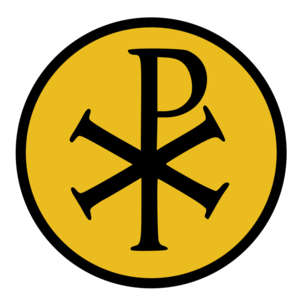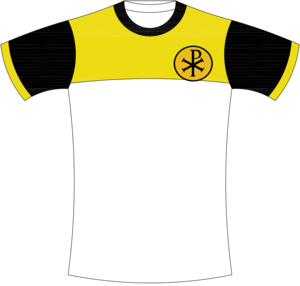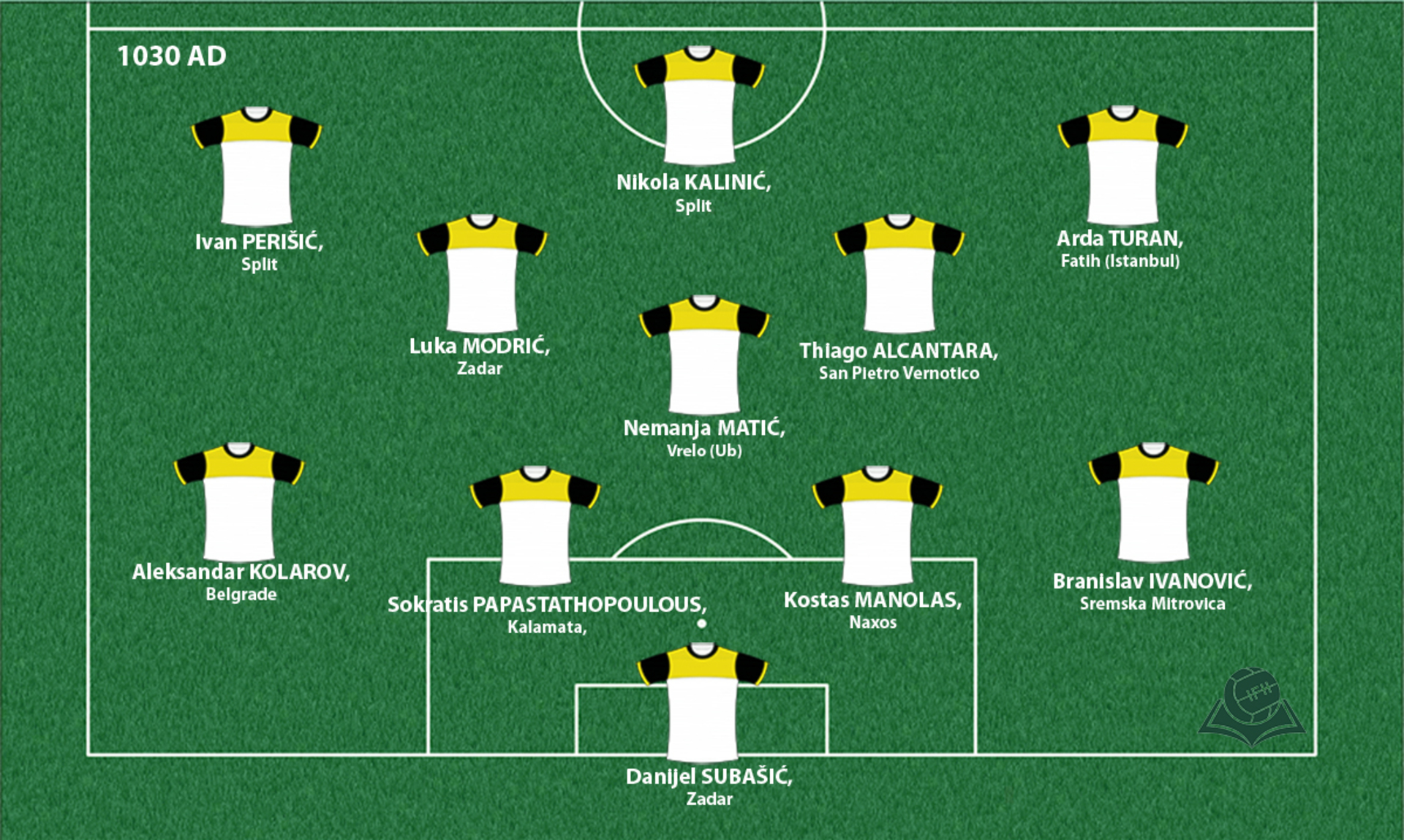The Byzantine Empire
In comparison to the West, during the Early Middle Ages, different Christian and culturally heterogeneous civilization, which started to use Greek instead of the Latin language, was created in Byzantium.

Coat of arms

Shirt
| Position | First name | Last name | Mjesto rođenja | Like | Dislike | |
|---|---|---|---|---|---|---|
| GK | Danijel | SUBAŠIĆ | Zadar |
70 |
5 |
|
| GK | Etrit | BERISHA | Pristina |
17 |
26 |
|
| GK | Volkan | BABACAN | Antalya |
8 |
14 |
|
| DC | Kostas | MANOLAS | Naxos |
30 |
2 |
|
| DC | Matija | NASTASIĆ | Valjevo |
63 |
6 |
|
| DC | Stefan | SAVIĆ | Mojkovac |
46 |
5 |
|
| DRC | Branislav | IVANOVIĆ | Sremska Mitrovica |
43 |
15 |
|
| DRC | Sokratis | PAPASTATHOPOULOUS | Kalamata |
25 |
6 |
|
| DRL/MR | Stefan | RISTOVSKI | Skopje |
28 |
10 |
|
| DR | Elseid | HYSAY | Reç (Shkodër) |
14 |
9 |
|
| DL/ML | Aleksandar | KOLAROV | Belgrade |
45 |
13 |
|
| DL/MLC | Caner | ERKIN | Balıkesir |
11 |
13 |
|
| DMC | Luka | MILIVOJEVIĆ | Kragujevac |
30 |
9 |
|
| DMC | Nemanja | MATIĆ | Vrelo |
60 |
10 |
|
| DMC | Ozan | TUFAN | Bursa |
8 |
12 |
|
| MC | Luka | MODRIĆ | Zadar |
90 |
8 |
|
| MC | Nikola | MAKSIMOVIĆ | Belgrade |
27 |
14 |
|
| MC | Thiago | ALCANTARA | San Pietro Vernotico |
18 |
1 |
|
| AMRLC | Arda | TURAN | Fatih |
18 |
5 |
|
| AMRLC | Ivelin | POPOV | Sofia |
10 |
2 |
|
| AMRLC | Kostas | FORTOUNIS | Trikala |
23 |
10 |
|
| AMRL | Ivan | PERIŠIĆ | Split |
80 |
5 |
|
| AMRL | Mijat | GAĆINOVIĆ | Novi Sad |
9 |
10 |
|
| AMRL | Xerdan | SHAQIRI | Gjilan |
44 |
26 |
|
| SS/FC | Stevan | JOVETIĆ | Podgorica |
30 |
8 |
|
| FRLC | Domenico | BERARDI | Cariati |
19 |
2 |
|
| FRLC | Enes | ÜNAL | Bursa |
8 |
9 |
|
| FC | Burak | YILMAZ | Antalya |
10 |
10 |
|
| FC | Graziano | PELLE | San Cesario di Lecce |
12 |
3 |
|
| FC | Kostas | MITROGLOU | Kavala |
18 |
2 |
|
| FC | Nikola | KALINIĆ | Split |
48 |
11 |
|
| FC | Simone | ZAZA | Policoro |
4 |
2 |
|
| FC/SS | Pieros | SOTIRIOU | Nikosia |
1 |
1 |
(Today part of: Turkey, Greece, Cyprus, Bulgaria, central i southern Serbia, Albania, Montenegro, eastern part of Bosnia and Herzegovina, southern Crimea, Macedonia, Kosovo, southern Italy (withoutthe surrounding area of Naples) coastal cities in Croatia)
Simultaneously, ancient history was paralleled to paganism and idolatry and as such was undesirable in Byzantium, hence everything related to that period was either destroyed or their names and purposes were changed (e.g. temples), which eventually led to not using them until the 19th century. The Macedonian dynasty ruled the Byzantine Empire from 867 till 1057. During that period, the Empire restored its military in all fronts – Mesopotamian, Bulgarian/Macedonian and Mediterranean. At the beginning of the 11th century, Basil II (ruled from 976 till 1025) took on his great adversary from the west Macedonia, Samuel (ruled from 997 till 1014) who declared his country, which was spread in the southeastern Europe, as a successor of the Bulgarian Empire. During the 30-year war (986-1014), Basil II destroyed Samuel’s empire which was gradually destroying the Byzantine Empire itself.
Upon Basil II’s death, the borders of the Byzantine Empire were Danube, Antiochia and northern Syria, Armenia and the south of the Apennine peninsula. Additionally, christening in the ‘’land of the Rus’’ at the end of the 10th century enhanced the Empire’s impact. However, the Empire was endangered by different external assaults. Muslims threatened on the north, Seljuk Turks on the east, Normans of the west and Crusaders on the west. Furthermore, the churches in Rome and Constantinople were distancing themselves for centuries which in 1054 led to the Great Schism, i.e. the break of communion between the Eastern Orthodox and Catholic churches. Similarly, the scripts that were used – Latin and Cyrillic – has had cultural and political consequences separating European Eastern Orthodox and Catholic demos.
Sources
- Grupa autora, Povijest: Rani i razvijeni srednji vijek , knjiga VI., Zagreb 2008.
- Adrian HASTINGS, Gradnja nacionaliteta , Rijeka, 2003.
- Jacques LE GOFF, Civilizacija srednjovjekovnog Zapada, Zagreb 1998.
- Kristijan OBŠUST, ''Idealizovanje antičke Grčke klasičnog perioda kao „kolevke evropske kulture“. Stara Grčka kao univerzalni uzor za stvaranje modernih evropskih nacija'', http://www.journal.casca.org.rs/2012/12/24/idealizovanje-anticke-grcke-klasicnog-perioda-kao-kolevke-evropske-kulture-stara-grcka-kao-univerzalni-uzor-za-stvaranje-modernih-evropskih-nacija/
- ''Samuilo'', (http://www.enciklopedija.hr/Natuknica.aspx?ID=54356)
- GRB https://www.tumblr.com/search/byzantine%20symbols
